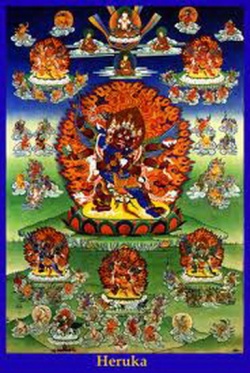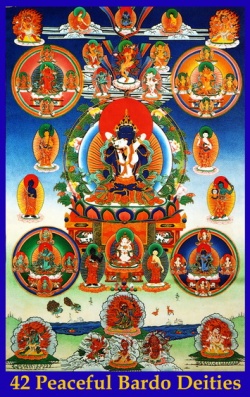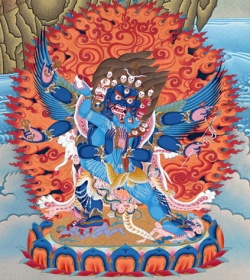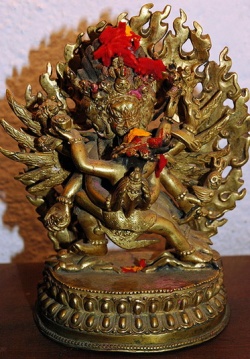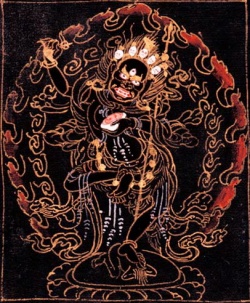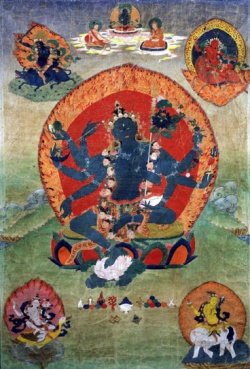Yidam Deities in Vajrayana
Click here to see other articles relating to word Yidam Deities in Vajrayana
Generally speaking, there are Three Vehicles of practice in Buddhism: Hinayana, Mahayana, and Vajrayana. Today I wish to speak about Vajrayana.
Meditating a yidam deity is central in Vajrayana. It is crucial for Vajrayana practitioners to know that Yidam Deities are not external to one’s own mind, rather they are images that help us work with our own mind. Yidams are the unblemished reflection of the primordial and innate true nature of our Mind that manifests in specific forms and colors. The purpose and goal of our practice is to attain perfect Buddhahood, which manifests in three aspects or forms at fruition – the Dharmakaya, Sambhogakaya, and Nirmanakaya. It is important to know that the Three Kayas are indivisible.
Describing the Three Kayas briefly: Dharmakaya is the true nature or essence of Buddhahood that appears as the Sambhogakaya; the two kayas are not separate from one another. The Dharmakaya, that has no form and is therefore intangible, is the vast state or fundamental ground of the mind’s true nature that is free from inherent existence and adventitious stains; it cannot be fathomed and cannot be described in words. The unblemished, vast ground of one’s mind that is free from discursive thoughts, the Dharmakaya, is replete with great clarity and creativity and continuously manifests in a perceptible form, which, from the ultimate state of Buddhahood, is the Sambhogakaya, “the body of complete enjoyment.” Manifestations of the Sambhogakaya are referred to as yidam deities. A Vajrayana practitioner turns his or her attention towards a depiction of one of the many yidams that represent the ultimate state of enlightenment.
The great variety of Yidam deities have the same essence and are images of the many manifestations of enlightenment, for example, as Noble Chenrezig, Arya Tara, Bodhisattva Manjushri or the wrathful appearances such as Vajravarahi and Chakrasamvara. It’s important to distinguish between how things are and how things appear and to know that the essence of the manifold appearances of enlightenment is one and the same, namely the intangible Dharmakaya. Things appear in a limitless number of forms – thick, thin, flat, square, round, and so forth. They appear in many colors and in their combination – white, blue, yellow, red, and green. And so, enlightenment manifests in a great variety of forms and ways.
When we perceive and apprehend an appearance that accords with our propensities and inclinations – our wants and needs -, then we are happy about the appearance. When we apprehend an appearance that doesn’t accord with our personal inclinations, then we are less pleased with it. The manifestation of yidams, which are an expression of Enlightenment, are free from the necessity of appearing in a specific form or in a certain color, rather every yidam is a reflection of our personal wants and needs. Being an image of people’s various capabilities and inclinations, some yidams appear white in color, like Noble Chenrezig, others are blue, yellow, red, or green and have different forms. In truth, Yidams are the display of the immense Compassion of the Buddhas.
Is the yidam deity we meditate a truly existent, permanent entity? It is important to know that this is not the case. All yidams arise in dependence in that they are created by our own mind. If one meditates a yidam Deity that one creates and cultivates with one’s mind intensively for a long period of time and accomplishes the aim of the practice, then one will have realized the actual and true manifestation of the Sambhogakaya.
A beginning practitioner works at creating an image of a yidam like Noble Chenrezig by imagining his color and all details of his form as clearly as possible. It’s impossible for a beginner to see the image with opened eyes, so, knowing that one is engaging in the methods of practice by creating the image of a yidam, one closes one’s eyes lightly and practices seeing the inner image until one sees it clearly. If one practices diligently, then the Yidam one meditates will eventually directly manifest. A practitioner of the Buddhadharma strives to attain Buddhadhood, complete and perfect enlightenment that manifests as the Three Kayas at fruition.
Buddhahood is attained through the gradual process of transforming oneself into the body of perfect enlightenment by overcoming and finally eradicating one’s destructive emotions that are veils concealing one’s true nature. One’s body, speech, and mind manifest as primordial purity when Buddhahood has been attained. When one has attained Buddhaood, one’s Body will have been transformed into the Nirmanakaya, one’s speech into the Sambhogakaya, and one’s mind into the Dharmakaya. The three terms designate the goal that is eventually achieved through practice. Complete Purification of one’s impurities that conceal one’s true nature is called Dharmakaya, Sambhogakaya, and Nirmanakaya; they are called mind, speech, and body for ordinary beings who have not vanquished their impurities and who have not attained fruition. And all along, the essence of the pure kayas and the essence of the impure aspects of ordinary living beings are and always will be the same.
The main purpose of practice is to transform one’s impure perception of appearances and apprehension of experiences that determine one’s life into pure and untainted perceptions and apprehensions. Therefore, in order to cleanse one’s impure way of perceiving and apprehending things, one repeatedly meditates the immaculate appearance of a yidam deity. Practice consists of focusing one’s attention on a pure image of enlightenment, a yidam, until one’s perception of the purity of all appearances becomes clear and brilliant and determines one’s life. It isn’t possible to attain this goal right away, and that is why beginners fabricate thoughts about a yidam while cultivating it during meditation practice.
Beginners close their eyes and imagine the form, color, and ornaments of a specific yidam, i.e., they simultaneously practice creating the pure physical, verbal, and mental aspects of the yidam. The physical aspect of practice is visualizing the body of the yidam as clearly as possible. The verbal aspect is reciting the mantra of the deity. And the mental aspect is concentrating one’s attention one-pointedly on the image and mantra of the yidam without becoming distracted. Of course, it isn’t possible to perfect all three aspects of a yidam such as Noble Chenrezig all at once and from the start, so one begins slowly and step by step by concentrating on the eyes, then on the head of the deity, continuing with its shoulders and entire body. One practices again and again, and, like all things in life, practice makes perfect. Through repeated and regular practice over a longer period of time the entire image of the yidam will clearly appear in one’s mind.
Practitioners can have doubts and wonder whether the yidam exists or not and whether the practice is beneficial or not. There is no reason to have doubts if one is aware of the fact that the image of the yidam is not born outside oneself, since one knows that one is creating it with one’s imagination and with one’s Eyes closed. If one continues practicing, then eventually one will see the image of the pure deity as the manifestation of one’s own perception with opened eyes. It’s important to be assured that a practitioner doesn’t walk around seeing blue or white images holding flowers in their hands, rather fruition means that a successful practitioner sees phenomena free from any personal, conceptual and emotional blemishes.
Perception of the true nature of all appearances and experiences has three aspects – clarity, unchanging, and perfect purity. This means to say that by practicing meditation diligently, a practitioner eventually perceives the essence of phenomena clearly and brilliantly. Furthermore, he or she sees that the essence of phenomena doesn’t fluctuate by coming and going, but is changeless, and that it is perfectly pure, which means to say that it isn’t blemished by impeding veils of disturbing emotions and thoughts.
We are followers of Vajrayana, and the heart of the Vajrayana path is meditating a yidam deity. As said, it’s important not to have any illusions and to know that it isn’t easy to clearly perceive an enlightened yidam. Traditionally, yidam meditation practices were carried out in a three-year retreat, but if one practices diligently and becomes accustomed to generating and visualizing a deity, then eventually the visualization will arise clearly and distinctly.
Red Chenrezig is the main practice of Kagyüpa three-year retreatants. If a practitioner isn’t distracted and naturally and ease-fully abides in one-pointed concentration on Red Chenrezig for a while, then it can happen that he or she sees the entire room bathed in a vibrant, red color. It can also happen that retreatants lose their feeling for time, i.e., they lose their feeling for morning, noon, and night, even while taking their meals. This is a sign that a practitioner’s perception has become lucid, constant, and pure, i.e., he or she has become unaffected by time. These two examples are based upon my own experience. Another experience I had is that when the three aspects described above manifest, then one reaches a point at which every appearance is seen in the same way.
Meditating a yidam is extremely helpful when it comes to dealing with daily samsaric appearances and experiences that we continuously face. Cultivating and identifying with the pure appearance of a yidam deity again and again and over a longer period of time alleviates the impact that impure and painful experiences otherwise have. Everyone has problems and they vary from one person to the other. If a practitioner becomes accustomed to a pure yidam that is not made of matter, then the force and strength of problems that everyone encounters and that everybody has weaken and diminish and as a result it’s easier dealing with them.
There are three prerequisites for yidam practice to be beneficial: the person who meditates, the object of meditation, and the way the visualization is practiced. All three factors need to be united. It is very important to remember that the image of a yidam that one produces and cultivates in one’s meditation does not arise and exist outside one’s own mind. It would be a grave Illusion to think that the yidam one produces during meditation practice is an external entity that truly exists and is other than oneself. A yidam is a beneficial and wholesome projection of one’s own mind that one works with.
There are various ways of generating a yidam deity in the different traditions. For example, there is the tradition of visualizing a yidam in front of oneself in space and there is the tradition of visualizing oneself as a yidam. A practitioner visualizes Red Chenrezig both in space as well as himself or herself in the Form of the Deity during a three-year Retreat. One visualizes one’s ordinary body in the form of a yidam, because, as it is, one is extremely attached to one’s Body, speech, and Mind due to thinking that they truly exist and stand for a self one believes in and clings to. The purpose of visualizing oneself as a yidam is to diminish and slowly overcome attachment to the self that one believes in and clings to.
Meditating again and again that one’s body, speech, and mind are not different than the pure body, speech, and mind of a yidam and that they are indivisible decreases and eventually eradicates one’s attachment to the ordinary idea one has of oneself that one clings to and that one is convinced really exists. It happens naturally and isn’t hard identifying with one’s ordinary Body, speech, and mind and calling it “me,” and it isn’t easy giving up clinging to the impure Body, speech, and Mind one identifies with so strongly and points to as “I.” One needs to exert energy and practice, seeing one isn’t accustomed to experiencing the true and pure nature of one’s being. The aim of Vajrayana is to progressively replace one’s ordinary, gross perception with a pure perception of what is true.
Hinayana practitioners also learn to vanquish attachment to a self by intensively contemplating the impure substances that make up everyone’s body. Vajrayana practitioners, in contrast, do not give up clinging to a self by shunning appearances, rather they learn to purify their delusive relationship with appearances and experiences and then can give up their Attachment and clinging to what they call “self and others.” Mahayana practitioners realize that all appearances - including their own body, tiniest atoms, and all constituents - are empty of inherent existence and only exist in dependence on other things. By realizing the empty nature of all sensory perceptions and apprehensions, they purify their impure cognition of reality and in the process give up clinging to a self and others.
Lord Buddha presented many methods of practice so that we can purify our delusive apprehensions of the World and Sentient beings. Vajrayana practitioners engage in the result of the path while practicing, whereas followers of Sutrayana focus their attention on the cause that leads to the result. We saw that Buddhahood denotes realization of the indivisibility of the Three Kayas. Vajrayana practitioners identify with all three ultimate dimensions of reality, the result, by meditating and cultivating a yidam while on the path to enlightenment, which means to say that they take the result as the path.
Attainment of the result, Buddhahood, doesn’t mean arriving at another location or being transposed, rather it means having gradually transformed one’s subtle channels (nadi in Sanskrit), winds (prana), and vital essences (bindu). At Buddhahood, the subtle channels that support one’s body are completely purified and are the Nirmanakaya; the subtle winds that support one’s speech are purified and are the Sambhogakaya; and the vital essences that support one’s mind are purified to the extent that one’s ordinary, conceptual mind that creates dualistic thoughts is purified and transformed into pristine awareness, which is the true nature of one’s mind, the Dharmakaya.
There are four classes of Tantra in Vajrayana: Action tantra (kriya tantra in Sanskrit), conduct Tantra (charya tantra), yoga tantra (yoga Tantra), and hightest yoga tantra] (Anuttarayoga Tantra). Anuttarayoga Tantra is the profoundest level of practice that is carried out in the frame of the Six Yogas of Naropa, at which stage the subtle channels, winds, and vital essences are central. Practitioners of Anuttarayoga don’t visualize yidam deities anymore, but directly employ the pure aspects of body, speech, and mind, i.e., the unblemished manifestation of the self-perfected state. At fruition, our ordinary body, speech, and mnd are transformed into their innate purity, in which case our mind is free of all contrivances and abides in simplicity.
Generally speaking, the subtle channels, winds, and vital essences are very powerful. When blockages in the channels are unravelled, i.e., the knots untied, and the winds can flow through them smoothly, then a practitioner doesn’t become sick anymore. Sicknesses arise due to blockages and disturbances in one’s subtle body. These blockages and disturbances and their interplay bring on sicknesses and diseases, which one experiences with one’s mind with sadness and woe. This process is referred to as suffering. If through practice one frees one’s subtle channels, winds, and vital essences of knots and disturbances, then one will be healthy and will experience happiness and bliss. If one can unite one’s subtle body, speech, and mind with the purity of a yidam’s body, speech, and mind, then one’s channels, winds, and vital essences will have become purified and free. As a result, one will experience less sicknesses and suffering and, instead, one will experience happiness and joy. We saw that meditating a yidam is central to Vajrayana, just as it is central to Mahayoga, and we should know that Yidams are directly related to oneself and accomplished when one has perfectly purified one’s subtle channels, winds, and vital essences. And so, it is evident that Yidams don’t exist outside or are separate from us, but are images of our own purity.
It’s important to distinguish between a designated yidam and an actual yidam. When speaking of Noble Chenrezig, for instance, we are referring to a designated deity. The actual and true deity is one’s own purified body, speech, and mind. Impure appearances are impure perceptions and apprehensions. When one’s impure perceptions and apprehensions have been purified and therefore overcome, then one’s ordinary body, ordinary speech, and ordinary mind will have been transformed into a Vajra body, Vajra speech, and Vajra mind, which are the three aspects of enlightenment (the Nirmanakaya, Sambhogakaya, and Dharmakaya). At the moment, one isn’t able to connect or experience the actual yidam. So one identifies with a designated yidam that one produces with one’s thoughts in order to eventually experience and realize the actual yidam. A practitioner begins by visualizing and identifying as best as he or she possibly can with a completely pure yidam. Calm abiding or insight meditation are not topics of yidam practice, which deals with the practice of meditating a deity.
There are innumerable practices. Since followers and practitioners have a huge amount of varying propensities and inclinations, there are a great number of Yidams in Vajrayana, starting with their various colors and forms. The great number of yidam deities in Vajrayana can be compared to a menu in a big restaurant – every guest is free to choose the meal they prefer having. Vajrayana is like that too, seeing one’s practice is enhanced if the Yidam one creates accords with and satisfies one’s preferences and needs. There are practitioners who prefer meditating Noble Chenrezig, others feel more comfortable meditating Arya Tara; others want to meditate Sangye Menla, who is Medicine Buddha. Yet other practitioners want to meditate Buddha Amitabha. These deities appear in different forms, but, irrelevant of the outer form, every practice is beneficial and leads to the same result. There are many disciples who prefer meditating wrathful Yidams, such as Vajravarahi or Chakrasamvara or Kalachakra or Mahakala, and these practices bring the same result as meditating a peaceful Deity. There are disciples who fear practicing Mahakala, for example, whereas other disciples really like meditating Mahakala, and this is what is meant when speaking about individual propensities and inclinations. In any case, Vajrayana practice consists of identifying with a yidam, which is an extraordinary method when compared to practices taught in other vehicles.
Again, it’s important to differentiate between a yidam designated and created by one’s mind with one’s thoughts and the actual and true yidam. Hinayana and Mahayana followers often have great doubts when they see all the Vajrayana Deities and think, “What a lot of constructs that lead away from the Absolute truth.” So it’s important to differentiate and understand the meaning and purpose of yidam practice. Due to the exceptional methods, Vajrayana is also called “Secret Mantrayana.”
I have spoken briefly about the principle and foundation of Vajrayana practice here. Thank you very much.
Dedication
Through this goodness may omniscience be attained
And thereby may every enemy (Mental defilement) be overcome.
May beings be liberated from the ocean of samsara
That is troubled by waves of birth, old age, sickness, and death.
By this virtue may I quickly attain the state of Guru Buddha and then
Lead every being without exception to that very state!
May precious and supreme Bodhicitta that has not been generated now be so,
And may precious Bodhicitta that has already been never decline, but continuously increase!
May the life of the Glorious Lama remain steadfast and firm.
May peace and happiness fully arise for beings as limitless in number as space is vast in its extent.
Having accumulated merit and purified negativities,
May I and all living beings without exception swiftly
establish the levels and grounds of Buddhahood.
